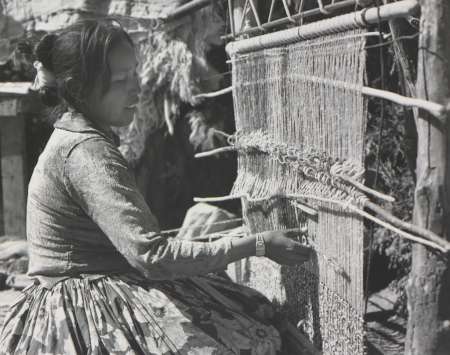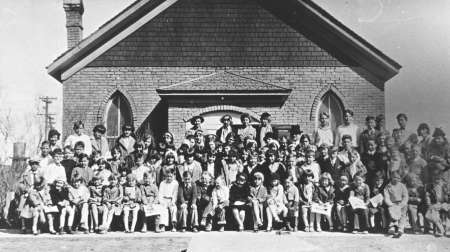- Whiteriver
- Fort Apache
- Apache Crafts
- Apache Profiles
- Customs and Traditions

Chief Alchesay, Washington DC
This photo was taken after a meeting in Washington DC, for Chief Alchesay to get permission to have cattle on the White Mountain Apache Reservation.
From left to right in front are Chief Alchesay’s son Baha, James M. Keys, Chief Alchesay, Grey Oliver (interpreter), Chief Tzizy, and Superintendent Charles Davis.
photo id: 364
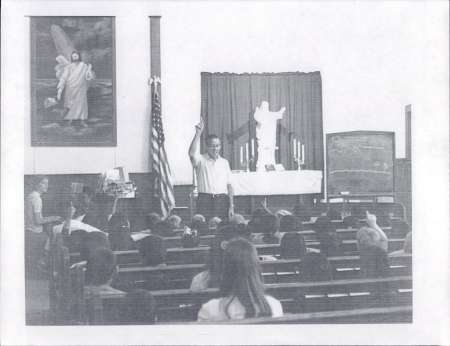
Lutheran Church in Whiteriver
The Church of the Open Bible has a rich history. Nestled in the White Mountains on the land of the White Mountain Apache Tribe, the church still exists in the same building dedicated by Chief Alchesay himself in 1922. He marched through the doors and asked that he and his people be baptized. He told everyone to listen to the “tall missionary” when he speaks from God’s Book.
photo id: 400
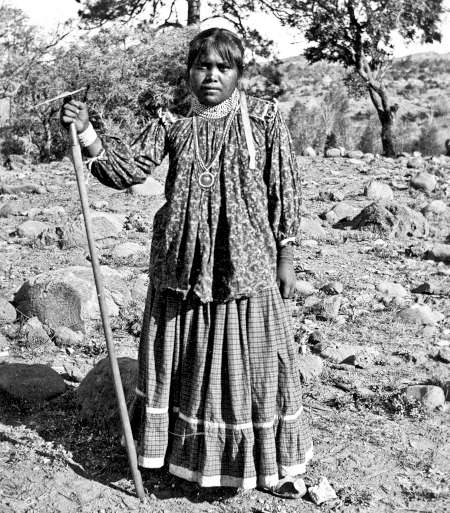
Apache Girl
An Apache girl working on crops on the White Mountain Apache Reservation around 1920.
photo id: 612
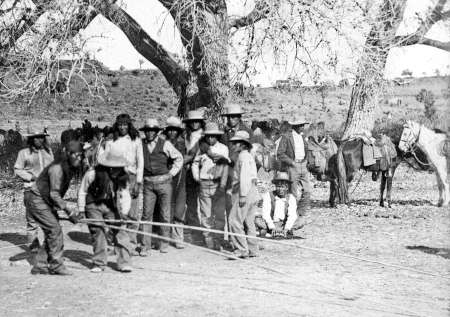
Apache Hoop Game
Apache game with hoop and sticks ca. 1920
photo id: 613
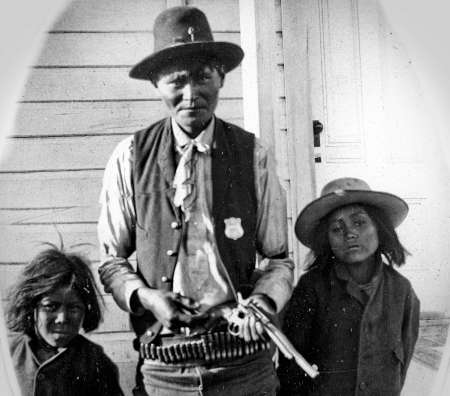
Apache Tribal Law Officer
Apache tribal Law Officer ca. 1920
photo id: 614
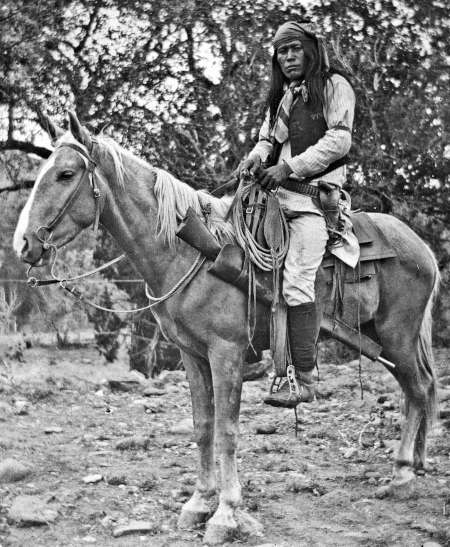
Apache Chief
Apache Chief ca. 1920
photo id: 615
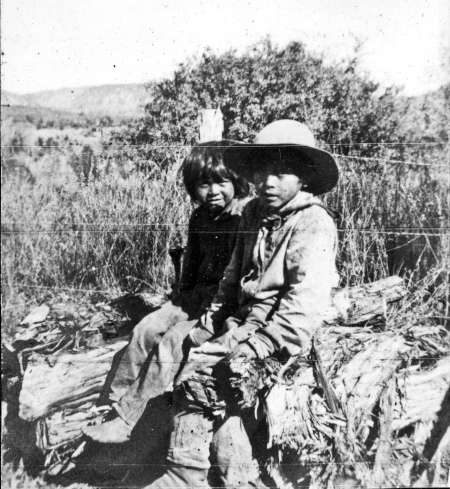
Apache Boys
Apache boys ca. 1920
photo id: 616
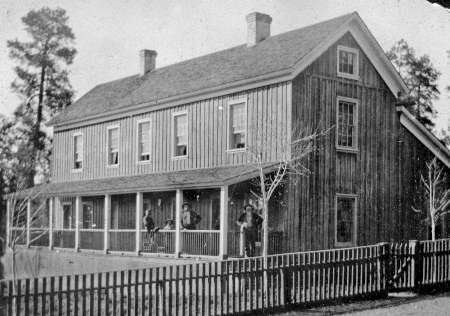
House of Corydon Cooley
House of Corydon Cooley (nearest man on the porch). Located a few miles south of present day Hon-Dah, the Cooley Ranch was noted for hospitality to all comers. It acted as an important stopping point for soldiers and travelers on their way to Fort Apache.
photo id: 618
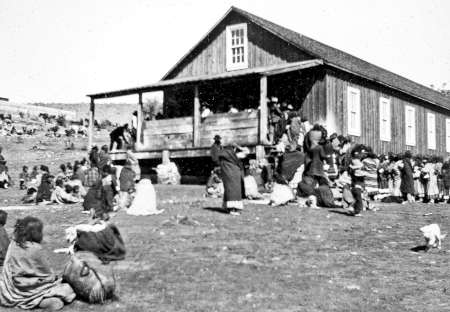
Ration Day
Ration Day – ca. 1920. Native Americans were given rations of basic necessities like corn and beans. The government purchased the rations from local farmers including the Indians themselves.
photo id: 619
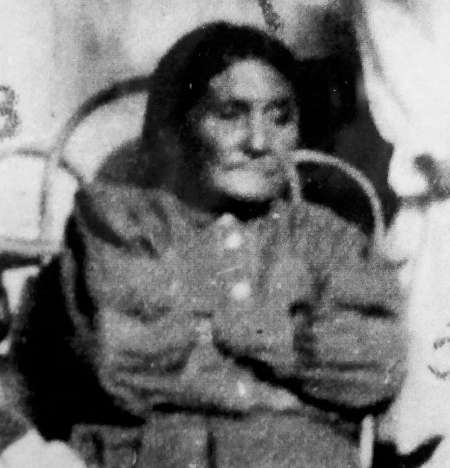
Molly
Molly, the Apache wife of Corydon Cooley in 1917. She died in 1920.
photo id: 621
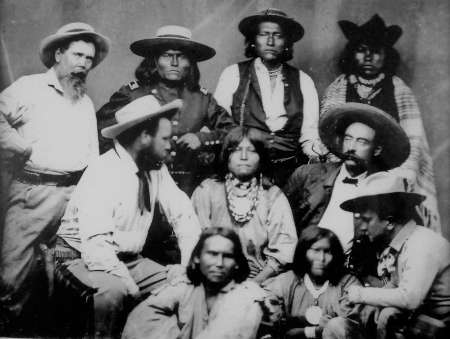
Apache Scouts
Apache Scouts. In the upper left corner is Corydon Cooley.
photo id: 622

Apache Chief Pedro
Cibecue Apache Chief Pedro was born ca. 1835 and lived until around 1895. He was chief of the Carrizo band until being driven off the Carrizo Creek by Miguel during a clan dispute. Two years later he and his band were allowed by Eastern White Mountain Apache Chief Esh-kel-dah-sila to settle near Fort Apache.
Chief Pedro was the father of Molly and Cora (wives of Corydon Cooley), and respected tribal leaders Alchesay and Baha Alchesay.
photo id: 623
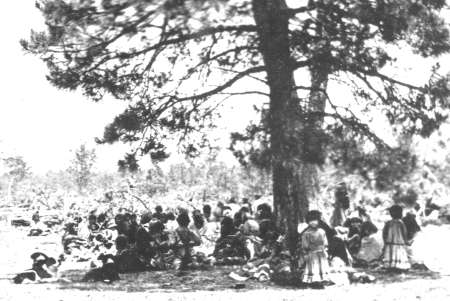
July 4, 1918
Apaches celebrating July 4th in McNary – ca. 1918
photo id: 624
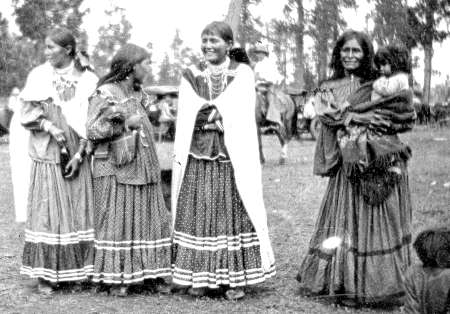
Party Clothes
Apache women in “party clothes” ca. 1918
photo id: 625
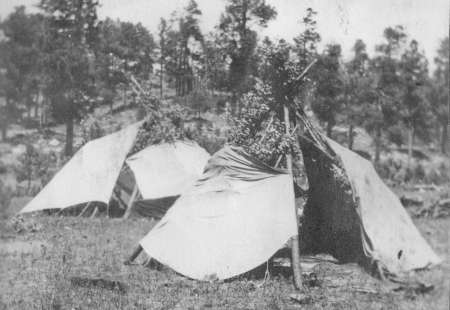
Apache Summer Dwellings
Early Apache summer dwellings were comfortable and practical. Airy and cool on hot days but with sufficient protection from summer rains. ca. 1918
photo id: 626
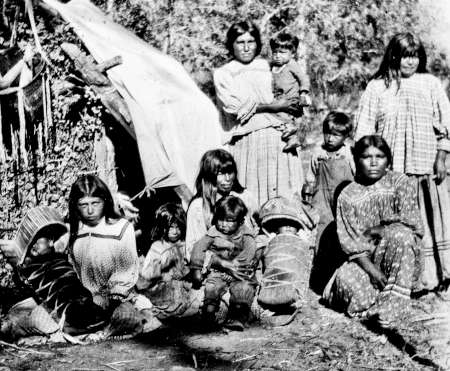
Summer Camp
Apache family enjoying summer camp. ca. 1918
photo id: 627
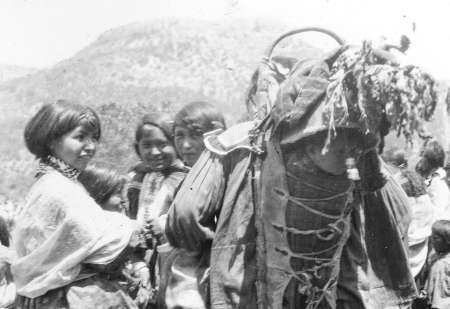
Apache Cradleboard
Apache women ca. 1900. Like so many things in Apache life, the cradleboards were a practical solution to a busy life. It allowed mothers to keep their hands free for the endless tasks of cooking, gathering fuel and food, and taking care of their close families.
photo id: 628
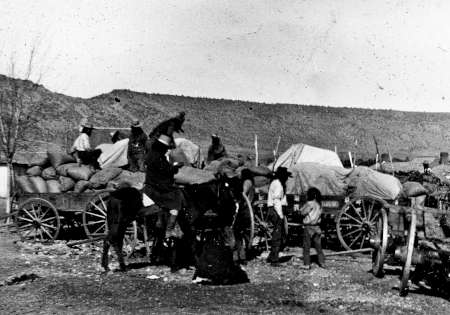
Selling Corn
Apache farmers selling corn to the government for two cents per pound at the turn of the century. Sales provided important cash income and the corn was distributed to soldiers and other Native Americans.
photo id: 629
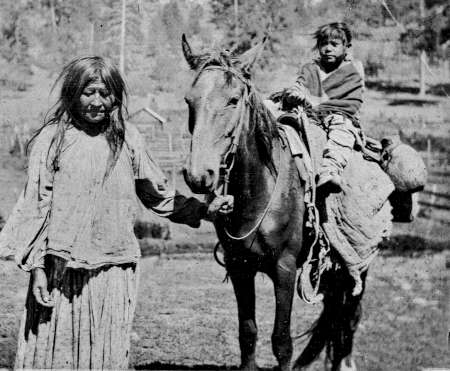
Shopping Trip
Apache mother and child returning home from a “shopping trip” ca. 1900
photo id: 630
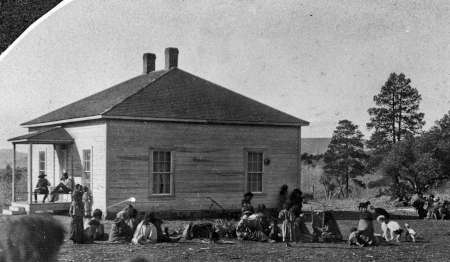
Reservation School
Reservation school for Indian children ca. 1900. Many Native American children were taken from their families and sent to distant boarding schools where they were forbidden to speak their native language or practice their culture.
photo id: 631

Selling Corn
Apache farmers arriving with a load of corn to sell to the government. The price was two cents per pound (ca. 1900). The corn was an important food for the ever-hungry soldiers, Native Americans, and livestock.
photo id: 633
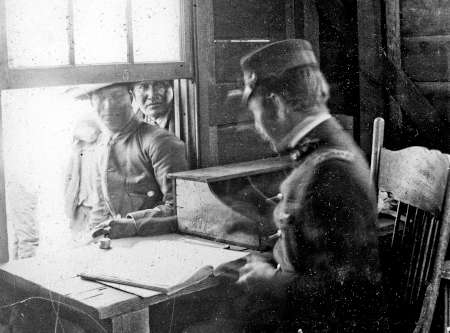
Payday!
Payday! Apaches earned valuable cash income from assisting the Army with scouting and horse wrangling. Rare photo ca. 1900
photo id: 634
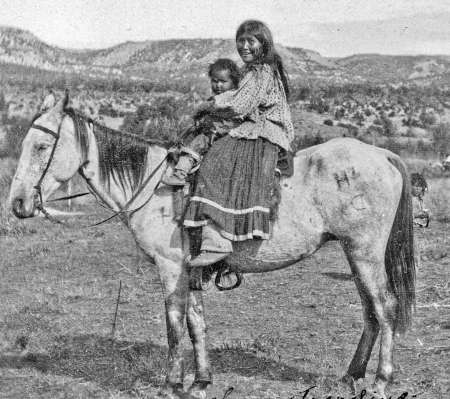
Apache Mother and Child
Apache mother and child. ca. 1900
photo id: 636

Lutheran Church
Lutheran church at Whiteriver ca. 1900
photo id: 637
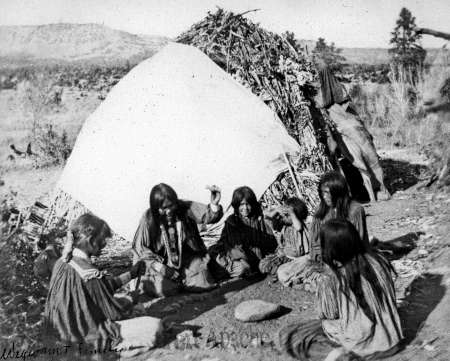
Summer Camp
Apache family in summer camp ca. 1900.
photo id: 638
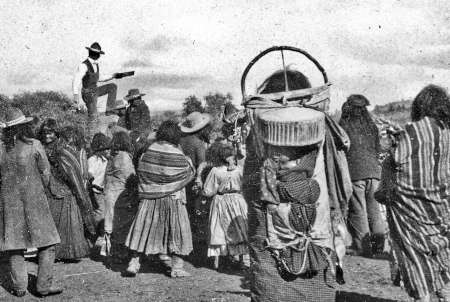
Receiving Rations
Apaches ready to receive rations. ca. 1918
photo id: 639
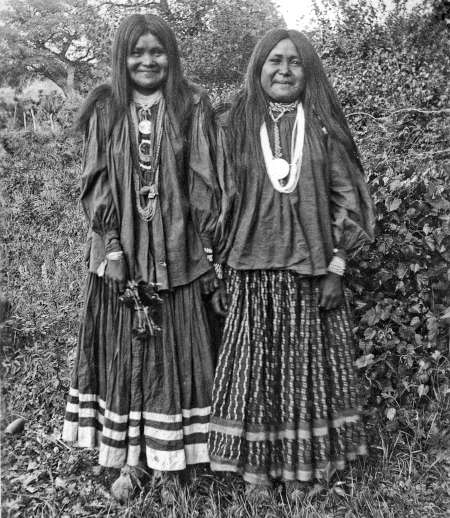
Ready to Celebrate
Apache girls dressed to go to a celebration. Ca. 1918
photo id: 640
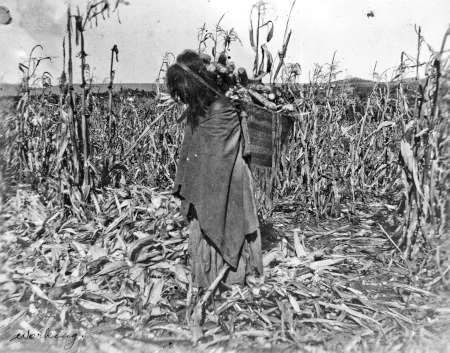
Girl Gathering Corn
Apache girl gathering the corn harvest around 1918. With no access to machinery, agriculture was back-breaking work for everybody in the family.
photo id: 641
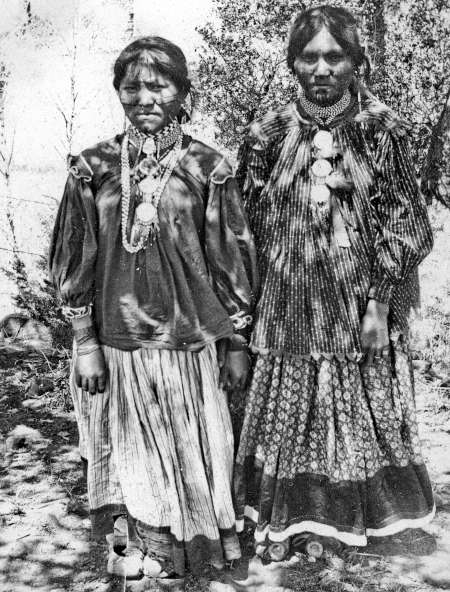
Apache Girls
Apache girls in finery ca. 1918
photo id: 642
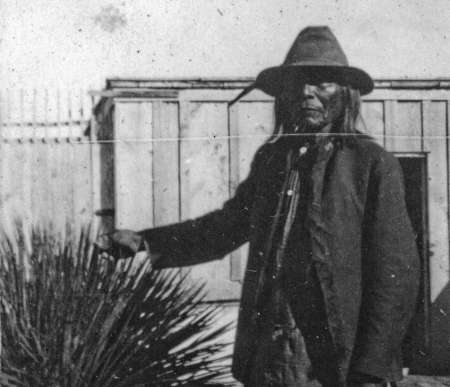
Apache Man
Apache man ca. 1920
photo id: 643
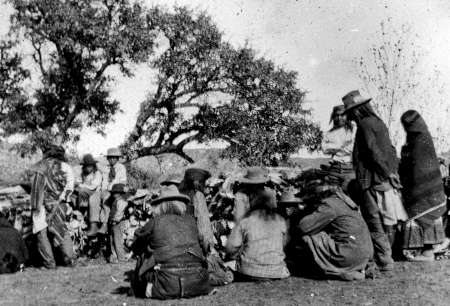
Apaches
Apaches. Photo was taken around 1920.
photo id: 644
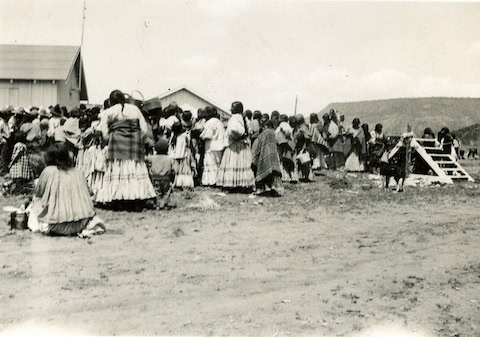
Fairgrounds
The annual fair in the 1930s. Photographed by Wayne T. Pratt.
Photo courtesy of Nohwike’ Bágowa Museum, White Mountain Apache Tribe
photo id: 886

Rodeo
The annual rodeo in the 1930s. This photograph was taken by Wayne T. Pratt.
Photo courtesy of Nohwike’ Bágowa Museum, White Mountain Apache Tribe
photo id: 887
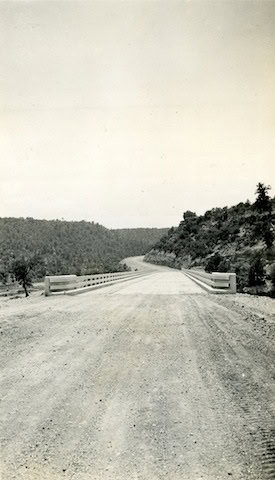
Highway 60
Photo taken by Wayne T. Pratt in the 1930s.
Courtesy of Nohwike’ Bágowa Museum, White Mountain Apache Tribe.
photo id: 892
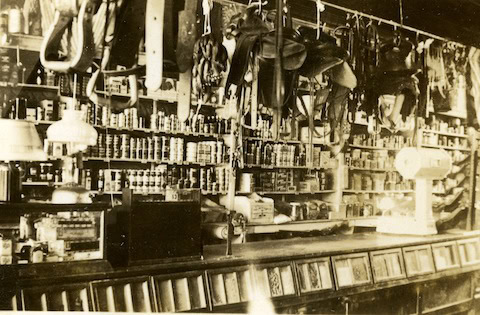
Trading Post
The interior of the trading post.
Photo courtesy of Nohwike’ Bágowa Museum, White Mountain Apache Tribe
photo id: 894
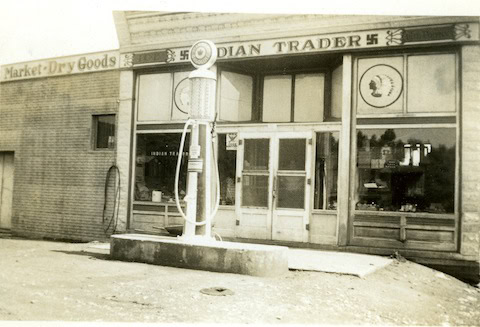
Trading Post
A trading post in Whiteriver. Taken by Wayne T. Pratt in the 1930s.
Photo courtesy of Nohwike’ Bágowa Museum, White Mountain Apache Tribe
photo id: 895
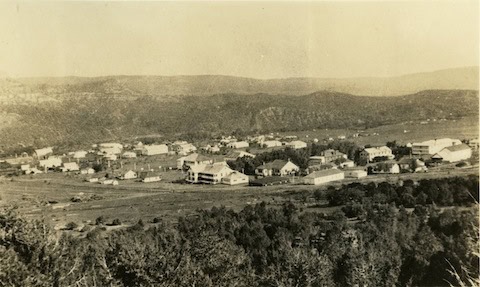
Whiteriver Aerial View
An aerial photograph of Whiteriver in the 1930s, taken by Wayne T. Pratt.
Photo courtesy of Nohwike’ Bágowa Museum, White Mountain Apache Tribe
photo id: 896
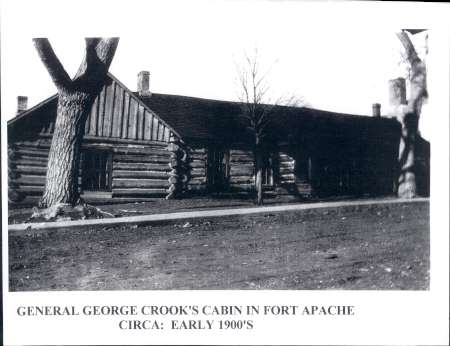
General Crook’s Cabin
Pictured here is General George Crook’s cabin in the early 1900s.
On May 16, 1870 an army post was established near the present town of Whiteriver in order to assist the White Mountain Apache Tribe to peacefully protect their lands. That same month the post and surrounding area was designated as a reservation for the Apache tribe.
Fort Apache is perhaps most widely recognized in association with the famous renegade leaders from various Apache bands, such as Geronimo and Cochise, who were pursued by the soldiers from Fort Apache and the White Mountain Apache Scouts, including Chief Alchise and Diablo. These men were instrumental in bringing a lasting peace to the Southwest.
photo id: 361
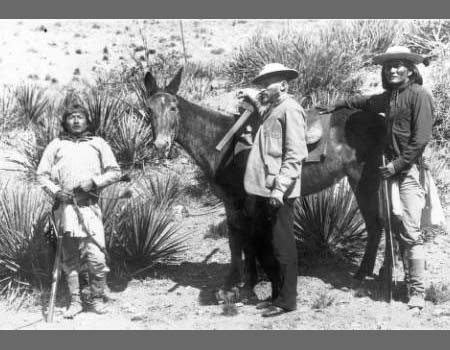
Captain George Crook
Captain George Crook stands with Native American (Chiricahua) Dutchy (Ba-keetz-ogie, the Yellow Coyote) and Al-chi-say, chief of White Mountain Apaches, both with rifles; they are next to a saddled mule with Crook’s double barrel rifle.
Western History/Genealogy Department, Denver Public Library
photo id: 1095
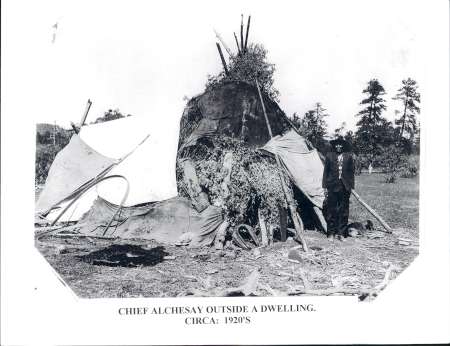
Apache Wickiup
Pictured here is Chief Alchesay standing outside a wickiup, the traditional housing for the Apache Indians that allowed them to live their semi-nomadic lifestyle.
These structures were primarily used for sleeping because all other activities, such as cooking, were done outside. This wickiup is one from Fort Apache, located on the White Mountain Apache Reservation in Northeastern Arizona.
photo id: 420
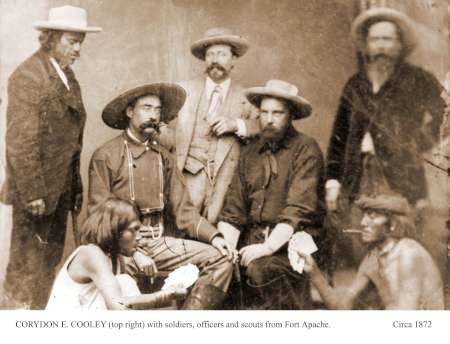
Cooley and Soldiers at Fort Apache
Corydon Cooley is pictured to the far right with officers and scouts from Fort Apache circa 1872. Unfortunately no other names or information about the picture are available. You can see the Apache scouts have their cards spanned as if ready to play.
For forty years the Cooley’s provided welcomed hospitality for both military and civilian travelers on the road from Holbrook to Fort Apache.
We are indebted to the Cooley’s for bridging over many of the misunderstandings between the white people and the Apaches. They also paved the way for many Mormons to settle on the mountain and live peacefully with the Native Americans.
photo id: 180
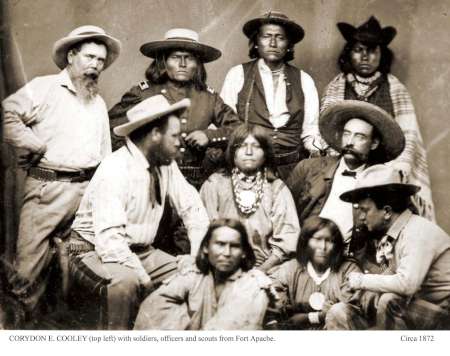
Cooley Fort Apache
This picture was likely taken prior to the wedding of Chief Pedro’s daughters dated 1872.
Corydon Cooley married one of Pedro’s daughters and bestowed upon her the American name of Mollie.
As was a frequent practice amongst the Apache, Mollie’s sister joined their new household. Some time later Corydon also married this sister. The custom of more than one wife was acceptable with the natives. This new wife was given the name Cora.
photo id: 181
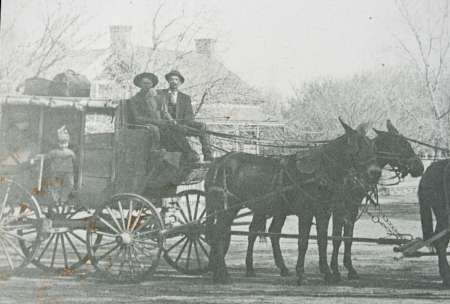
Army Ambulance
The U.S. Army Ambulance, pulled by a six mule team, was the fastest means of travel between Fort Apache and Holbrook.
photo id: 318
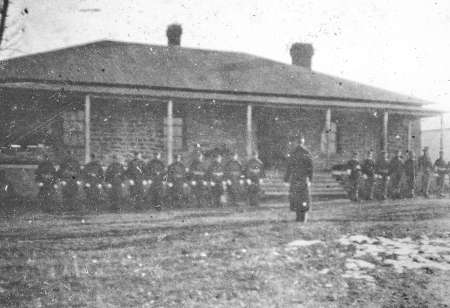
Soldiers at Fort Apache
Soldiers at Fort Apache assemble for guard mount, circa 1900.
photo id: 632

Barracks
Row of barracks at Fort Apache, circa 1900. Initially soldiers lived in tents when Fort Apache was established in 1870. They began constructing permanent buildings the following year.
photo id: 635
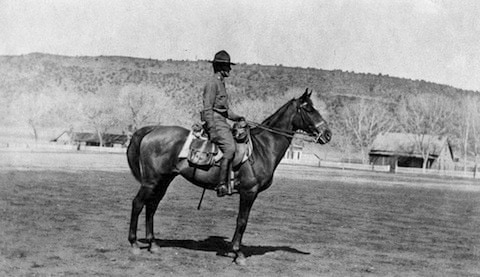
Parade Grounds
A soldier on a horse at the 10-acre Fort Apache parade grounds.
Photo courtesy of Nohwike’ Bágowa Museum, White Mountain Apache Tribe
photo id: 875
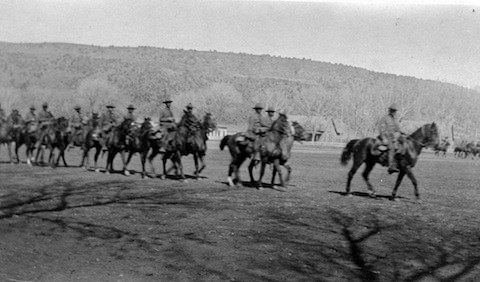
Cavalry
Cavalry troops on the Fort Apache parade ground.
Photo courtesy of Nohwike’ Bágowa Museum, White Mountain Apache Tribe
photo id: 876

Cavalry Practice
The 10th Cavalry, a segregated African American unit, practices a mounted pistol drill at Fort Apache.
Photo courtesy of Nohwike’ Bágowa Museum, White Mountain Apache Tribe
photo id: 891
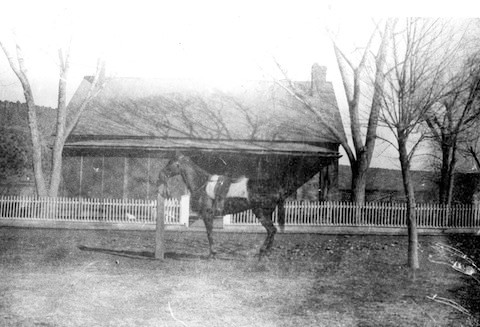
Captain’s Quarters
A thoroughbred horse stands in front of the Captain’s Quarters on Fort Apache.
Photo courtesy of Nohwike’ Bágowa Museum, White Mountain Apache Tribe
photo id: 877
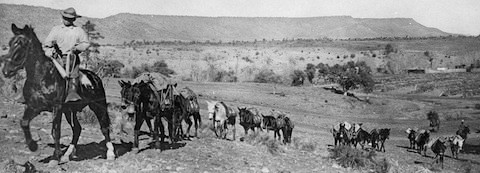
Pack Trail
A pack string headed south from Fort Apache.
Photo courtesy of Nohwike’ Bágowa Museum, White Mountain Apache Tribe
photo id: 879
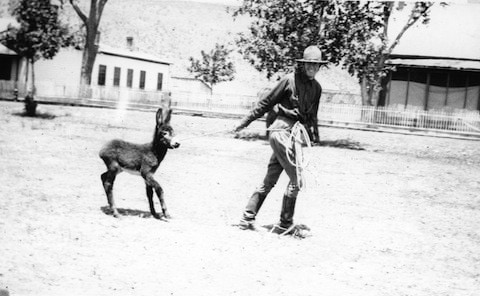
Baby Burro
A soldier with a baby burro at Fort Apache.
Photo courtesy of Nohwike’ Bágowa Museum, White Mountain Apache Tribe
photo id: 880
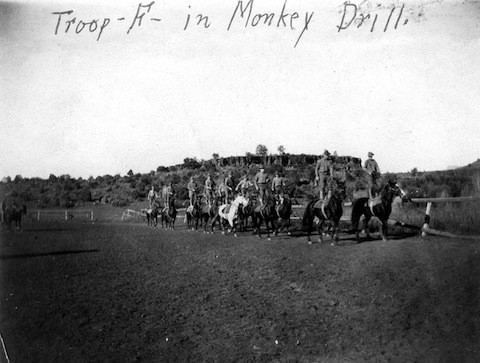
Monkey Drill
Troop F in Monkey Drill. Troopers from the 10th Cavalry (Buffalo Soldiers) at Fort Apache performed Roman Riding drills throughout the region.
Photo courtesy of Nohwike’ Bágowa Museum, White Mountain Apache Tribe
photo id: 883
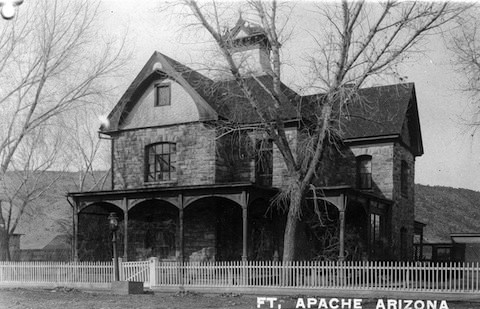
CO Quarters
Fort Apache Commanding Officer’s Quarters. Constructed in 1892, this 4,000 square foot house was the fourth and final built for the post’s CO. It was later used as the principal’s quarters for the Theodore Roosevelt School from 1923 until the 1980s.
Photo courtesy of Nohwike’ Bágowa Museum, White Mountain Apache Tribe
photo id: 884
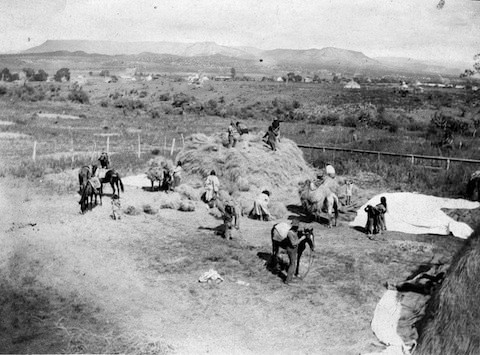
Selling Hay
Apache families bringing hay to sell to the Army at Fort Apache, circa 1918.
Photo courtesy of Nohwike’ Bágowa Museum, White Mountain Apache Tribe
photo id: 885
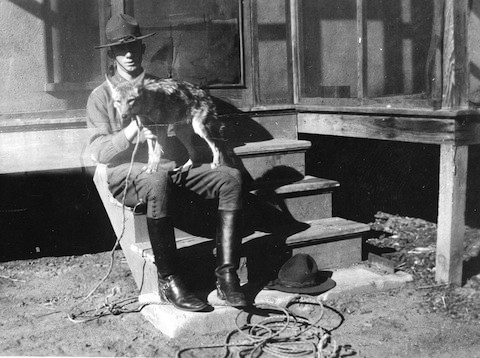
Coyote
A trooper with a “pet” coyote a Fort Apache.
Photo courtesy of Nohwike’ Bágowa Museum, White Mountain Apache Tribe
photo id: 872
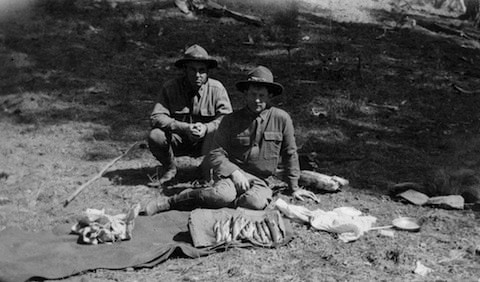
Fishing
Troopers with Apache Trout after a successful fishing trip.
Photo courtesy of Nohwike’ Bágowa Museum, White Mountain Apache Tribe
photo id: 873
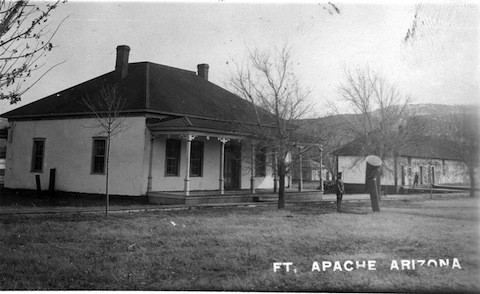
Adjutant’s Office
Fort Apache adjutant’s office, circa 1918. Photo courtesy of Nohwike’ Bágowa Museum, White Mountain Apache Tribe
photo id: 882
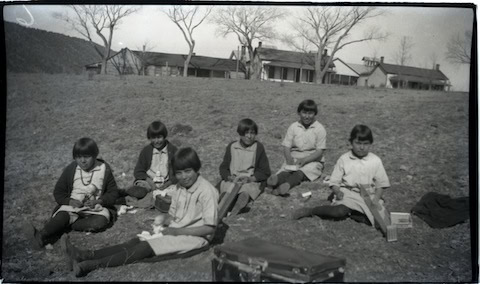
Dolls
Young girls with dolls and beads at the Theodore Roosevelt School at Fort Apache. This was taken in the 1920s by Bessie Kniffen Young.
The Army abandoned Fort Apache in 1922, and in 1923 the site became the home of the Bureau of Indian Affairs’ Theodore Roosevelt Indian Boarding School. Photo courtesy of Nohwike’ Bágowa Museum, White Mountain Apache Tribe
photo id: 866
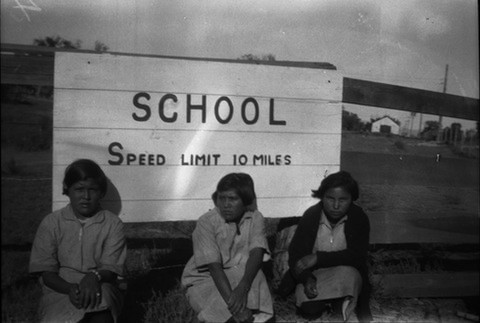
School Sign
Three girls with the Theodore Roosevelt School sign in Fort Apache. This was taken in the 1920s by Bessie Kniffen Young.
The children pictured are Diné, having been brought to the “off-reservation” Theodore Roosevelt School from their homes on the Navajo Nation. Prior to the 1930s, the children at Theodore Roosevelt were predominantly, if not exclusively, Diné. Apache children began to attend Theodore Roosevelt in the 1930s.
Photo courtesy of Nohwike’ Bágowa Museum, White Mountain Apache Tribe.
photo id: 864

Cabin
The original caption below this photo taken at the Theodore Roosevelt School reads:
“This shows the teachers of Home Economics in the background and a couple little children came along and wanted to be in the picture and also shows all of the log cabin where the teacher on the right Ms. Kastenhuber lived.”
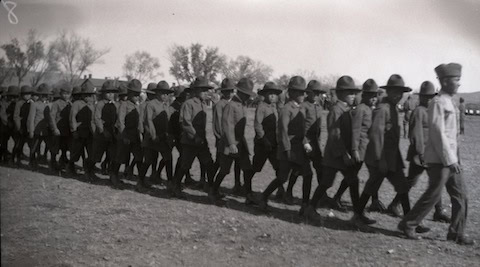
Uniformed Boys
Boys in uniform at the Theodore Roosevelt School in the 1920s. Fort Apache military culture lingered even after soldiers left; student drill teams marched on the parade ground after suppers.
Photo courtesy of Nohwike’ Bágowa Museum, White Mountain Apache Tribe
photo id: 867
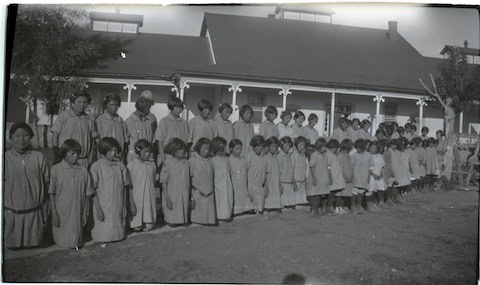
Line by Dorms
Girls lined up in front of their dormitory at the Theodore Roosevelt School at Fort Apache.
The school was originally intended to serve Diné (Navajo) children, by the 1930s a majority of students at the school were Apache.
Photo courtesy of Nohwike’ Bágowa Museum, White Mountain Apache Tribe
photo id: 868
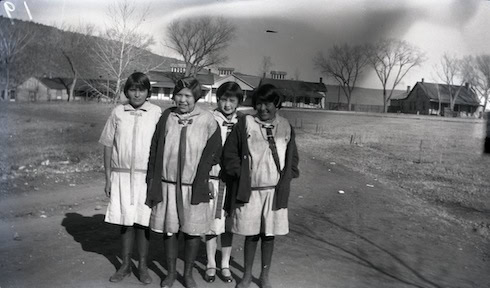
Cabin Road
Four girls standing on the road in front of the cabins at Theodore Roosevelt School in the 1920s. Initial enrollment when the school opened in 1923 was 250 Navajo and Hopi students. The students were in five grades and taught by five teachers.
Photo courtesy of Nohwike’ Bágowa Museum, White Mountain Apache Tribe
photo id: 869
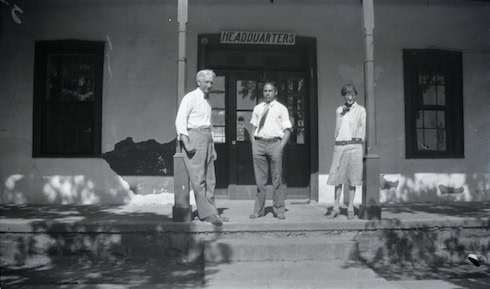
Headquarters
Anglo men and women on the porch at the Theodore Roosevelt School headquarters building. This photo was taken in the 1920s by Bessie Kniffen, a young teacher with a Christian missionary inclination.
Today Theodore Roosevelt School serves as a middle school under the administration of a school board selected by the Tribal Council.
Photo courtesy of Nohwike’ Bágowa Museum, White Mountain Apache Tribe
photo id: 870
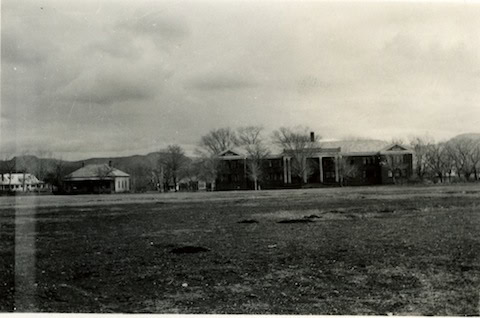
Boys’ Dormitory
The boys’ dormitory at Theodore Roosevelt Boarding School at Fort Apache was built in 1932. It is 23,000 square feet with two stories and a full basement. This photograph was taken by Wayne T. Pratt.
Photo courtesy of Nohwike’ Bágowa Museum, White Mountain Apache Tribe
photo id: 888
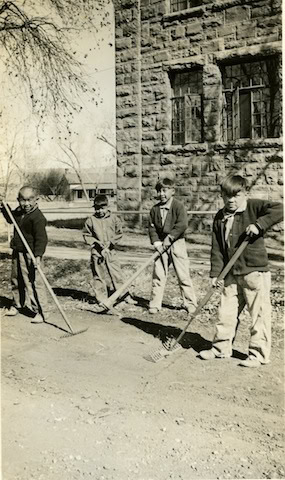
Chores
Young boys doing chores at the Theodore Roosevelt School. The school was mostly self-supportingl. Students were expected to help maintain the school by helping staff with day-to-day operations. This photograph was taken by Wayne T. Pratt.
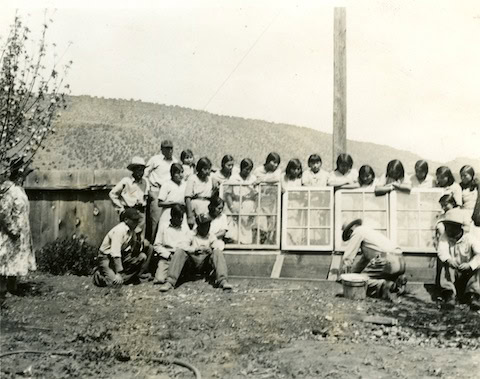
Outdoor Lecture
Instruction given by school farmer at the Theodore Roosevelt School in the 1930s.
Photo courtesy of Nohwike’ Bágowa Museum, White Mountain Apache Tribe
photo id: 893
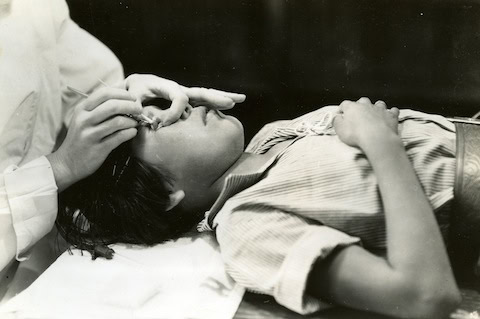
Trachoma
Wayne T. Pratt, the photographer, reports that Theodore Roosevelt School was to be closed as a boarding school following the Indian Reorganization Act of 1934, but instead was converted to a trachoma treatment school. That role was to be completed in the 1938-39 school year, after which Theodore Roosevelt transitioned back to a vocational school for Apache students.
During the period from 1934-1939 Theodore Roosevelt School was one of the few places where Indian children suffering from severe Trachoma could continue to go to school. Pupils were given treatment every morning six days a week. Treatment meant anesthetizing the eyelid with cocaine and then scraping the inflamed granulations off the eyelids and lining of the eye. Treatment was often prolonged, with multiple scrapings being performed.
Photo courtesy of Nohwike’ Bágowa Museum, White Mountain Apache Tribe
photo id: 890
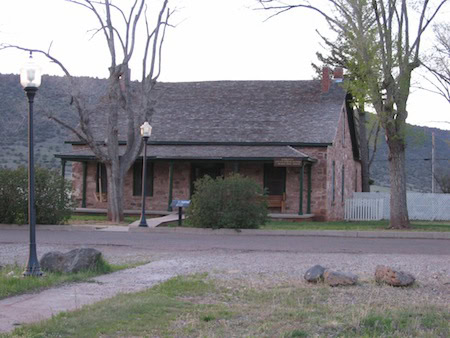
Captain’s Quarters
A recent photograph of the Captain’s Quarters at Fort Apache. There are two identical Captain’s Quarters buildings, made of sandstone. They were built in 1892 and are 3,630 square feet. Fort Apache is now a National Historic Landmark.
Photo courtesy of Nohwike’ Bágowa Museum, White Mountain Apache Tribe
photo id: 957
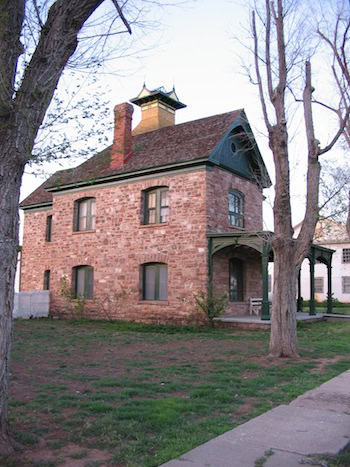
Commanding Officer’s Quarters
A recent photograph of the Commanding Officer’s quarters, which was built in 1892. It was also the Theodore Roosevelt School principle’s home from 1923 until the 1980s.
Photo courtesy of Nohwike’ Bágowa Museum, White Mountain Apache Tribe
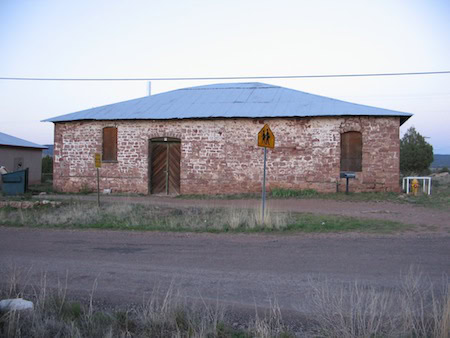
Guardhouse
A recent photograph of one of the Fort Apache guardhouses.
Photo courtesy of Nohwike’ Bágowa Museum, White Mountain Apache Tribe
photo id: 959
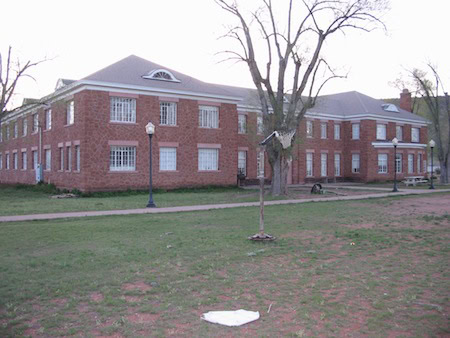
Girls Dormitory
A recent photograph of the Girl’s Dormitory at the Theodore Roosevelt School. It was built in 1931 to replace the old dormitory which burned down the previous year. It was used as the girl’s dormitory until 1990, and has been a co-ed dorm since 1999.
Photo courtesy of Nohwike’ Bágowa Museum, White Mountain Apache Tribe
photo id: 960
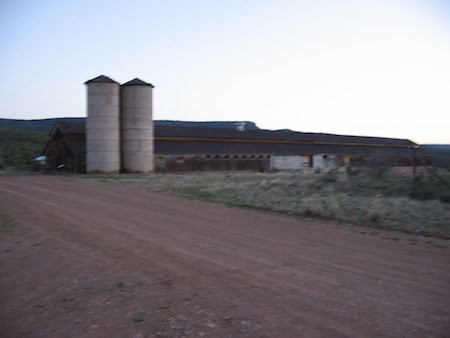
Stable
A recent picture of the stables, which were built in 1904 to replace the one that burned down the previous year. It was later used as a dairy barn, and is now used for storage.
Photo courtesy of Nohwike’ Bágowa Museum, White Mountain Apache Tribe
photo id: 961
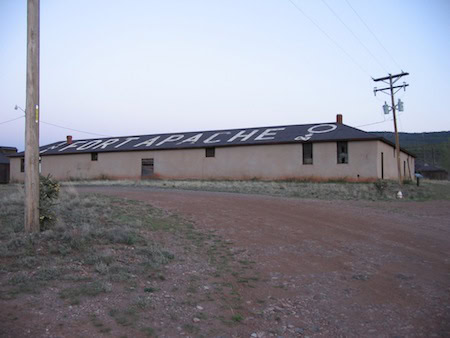
Quartermaster’s Store
A recent photo of the Quartermaster’s Storehouse, completed in 1889. It’s been used for Army and Bureau of Indian Affairs equipment and supply storage and distribution ever since.
Photo courtesy of Nohwike’ Bágowa Museum, White Mountain Apache Tribe
photo id: 962
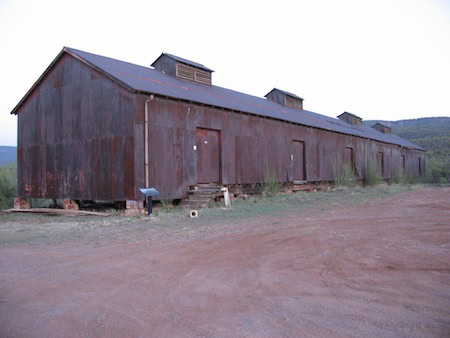
Granary
A recent photograph of the Granary, which was built in 1904. The Army used it for feed storage until 1922, and it has been used for equipment and supply storage ever since.
Photo courtesy of Nohwike’ Bágowa Museum, White Mountain Apache Tribe
photo id: 963
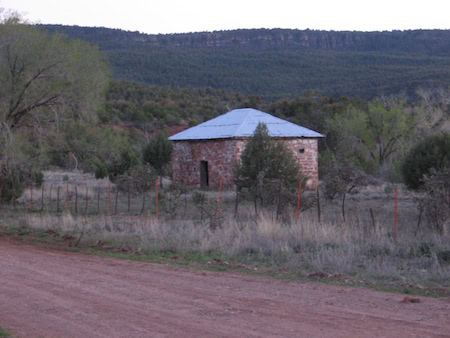
Magazine
A recent photograph of the 1886 magazine. It was built for ammunition and explosive storage.
Photo courtesy of Nohwike’ Bágowa Museum, White Mountain Apache Tribe
photo id: 964
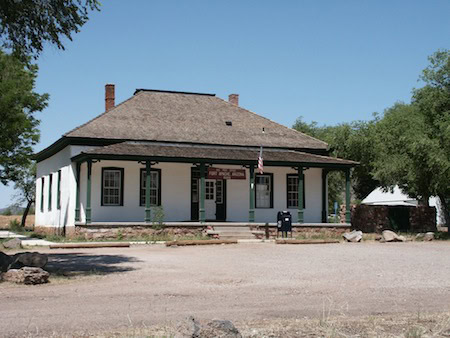
Adjutant’s Office
A recent photograph of the Adjutant’s Office, built in 1876. It was used as an administration center until 1920, and then became a post office.
Photo courtesy of Nohwike’ Bágowa Museum, White Mountain Apache Tribe
photo id: 965
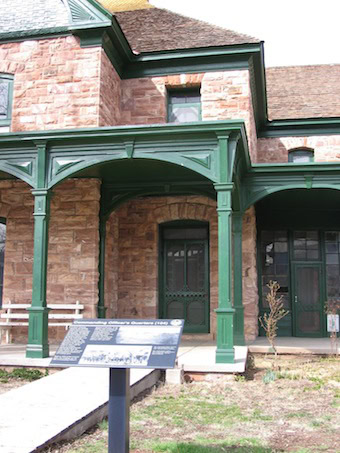
Log Cabin
A recent photograph if the Fort Apache Log Cabin. Built in 1871, this building was used early on as the Commanding Officer’s Quarters. Later the Theodore Roosevelt School used it for Home Economics. Currently the building is used for museum exhibits.
Photo courtesy of Nohwike’ Bágowa Museum, White Mountain Apache Tribe
photo id: 966

Officer’s Row
A recent photograph of the row of Officer’s housing at Fort Apache. There are 12 buildings along Officer’s Row, built between 1872 and 1982.
Photo courtesy of Nohwike’ Bágowa Museum, White Mountain Apache Tribe
photo id: 967
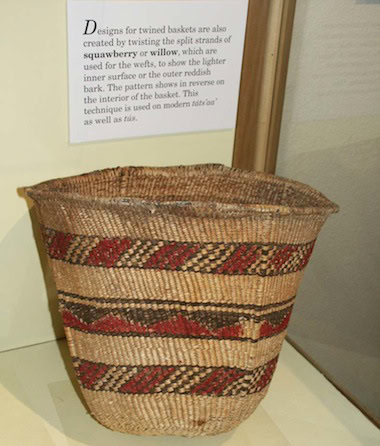
Basket
Photo courtesy of Nohwike’ Bágowa Museum, White Mountain Apache Tribe
photo id: 949
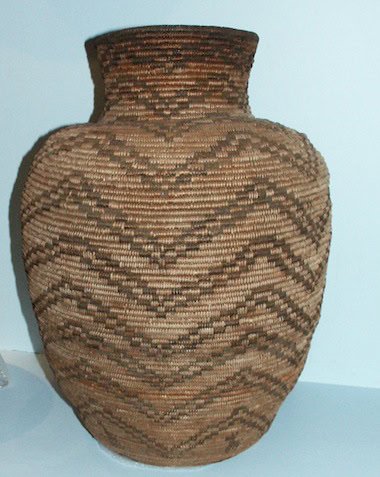
Large Basket
Photo courtesy of Nohwike’ Bágowa Museum, White Mountain Apache Tribe
photo id: 950
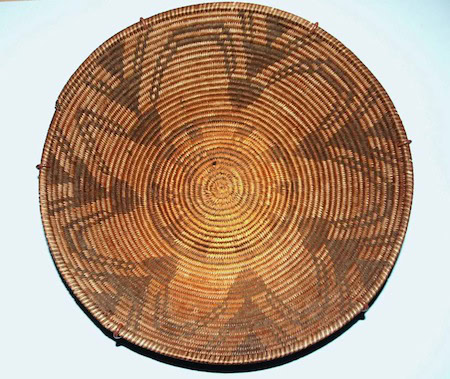
Flower Design
Photo courtesy of Nohwike’ Bágowa Museum, White Mountain Apache Tribe
photo id: 951
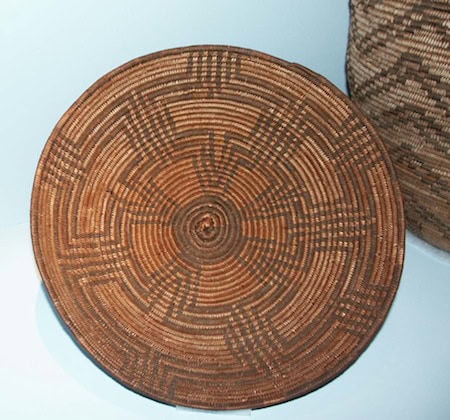
Inside
Photo courtesy of Nohwike’ Bágowa Museum, White Mountain Apache Tribe
photo id: 952
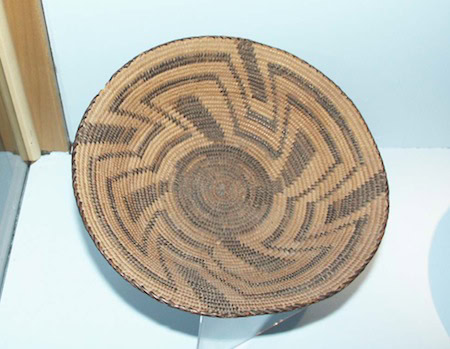
Pinwheel Design
Photo courtesy of Nohwike’ Bágowa Museum, White Mountain Apache Tribe
photo id: 953
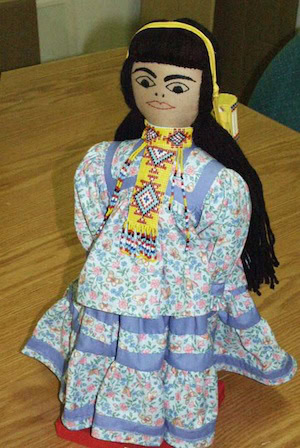
Doll
A doll believed to have been made by Cornelia Skidmore.
Photo courtesy of Nohwike’ Bágowa Museum, White Mountain Apache Tribe
photo id: 954
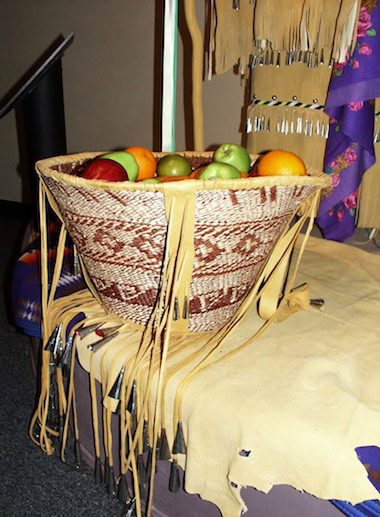
Exhibit Basket
Photo courtesy of Nohwike’ Bágowa Museum, White Mountain Apache Tribe
photo id: 955
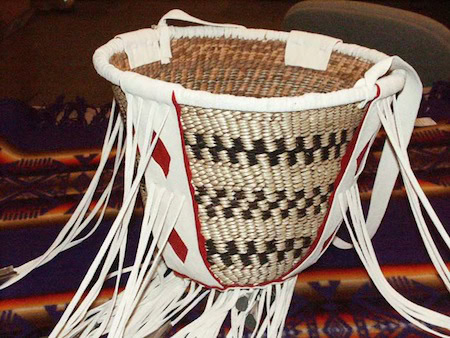
Marilyn’s Basket
A basket made by White Mountain Apache weaver Marilyn Hume in 2004 using an old style of decoration with red fabric underlying the buckskin “dressing.”
Photo provided by the Taylor/Shumway Heritage Foundation in Taylor, Arizona.
Photo courtesy of Nohwike’ Bágowa Museum, White Mountain Apache Tribe
photo id: 956

Container Collection
Nine containers: baskets, bowls, and jars.
Photograph taken by Edward Curtis, circa 1907.
photo id: 1087
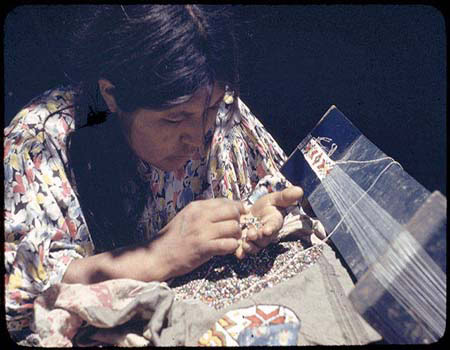
Apache woman, Irene selecting beads for her work
White Mountain Apache woman, known as Irene creating beaded works. 1940
Repository Northern Arizona University Cline Library
Call Number NAU.PH.3.5.6.9
Item number 51273
Photo from http://archive.library.nau.edu
photo id: 1189
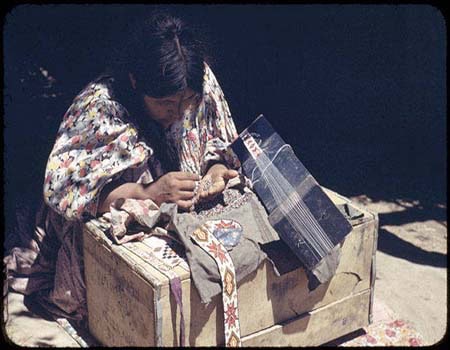
White Mountain Apache woman Irene with beads
Irene with beads, a work in progress and finished beadwork. Whiteriver, Arizona, 1940
Repository Northern Arizona University Cline Library
Call Number NAU.PH.99.3.5.5.13
Item number 51334
Photo from http://archive.library.nau.edu
photo id: 1190
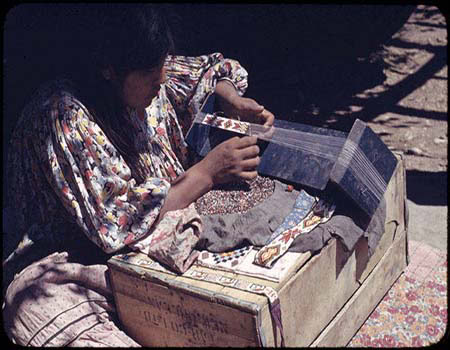
Apache woman, Irene, doing beadwork at Whiteriver, Arizona, 1940
White Mountain Apache woman Irene doing beadwork. Note the intricacy of the design.
Repository Northern Arizona University Cline Library
Call Number NAU.PH.99.3.5.6.8
Item number 51272
Photo from http://archive.library.nau.edu
photo id: 1191
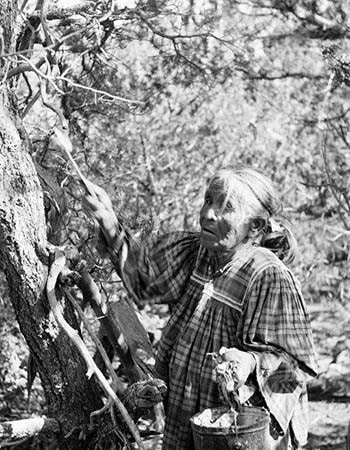
Elderly woman gathering pitch for baskets
Elderly Apache woman with knife and bucket gathering pitch 1941
Northern Arizona University, Cline Library Colorado Plateau Archives NAU.PH.99.3.5.8.3
photo id: 1104
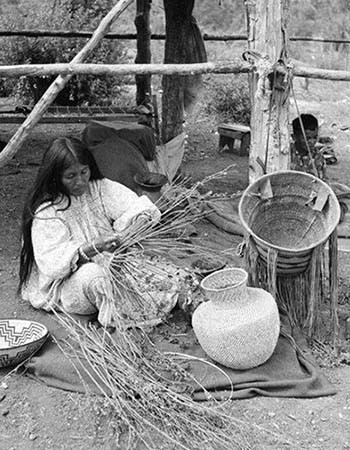
Flora Erskine, Basket Weaver
Apache basket weaver, Flora Erskine, Whiteriver, AZ 1941
Credit: Northern Arizona University. Cline Library (Tad Nichols Manuscript Collection) NAU.PH. 99.3.5.7.4
photo id: 1091

Flora Erskine
Apache basket weaver, 1941. Flora Erskine, weaver
Credit: Northern Arizona University, Cline Library Colorado Plateau Archives NAU.PH.99.3.5.7.5
photo id: 1106
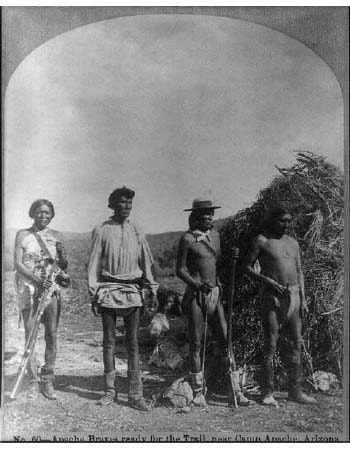
Apache Braves ready for trail near Camp Apache, Arizona.
Apache men pose outdoors with rifles near a brush shelter in Arizona. They wear boot moccasins and breechcloths., a wickiup is in the background. 1873 stereograph.
Western History/Genealogy Department,
Denver Public Library
Reproduction Number
X-33875
photo id: 1188
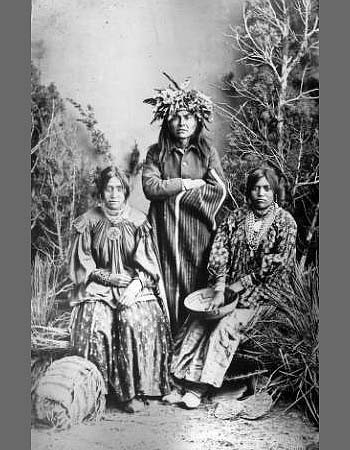
White Mountain Apache group
Studio portrait (sitting and standing) of WhiteMountainApachewomen and a man. The women wear dresses and bead necklaces. One woman wears a medal pendant, the other holds a basket. The man wears a blanket and a feather roach. The roach is a sign of a medicine man.
Title: White Mountain Apache group
Keywords: White Mountain Apache, clothing and headdress
Western History/Genealogy Department,
Denver Public Library,
Reproduction number W-32859
photo id: 1194
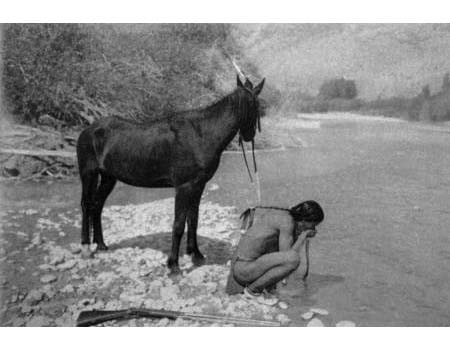
An Apache man drinks from Navajo Creek in Arizona. His rifle and horse are nearby
Courtesy Western History/Genealogy Department, Denver Public Library
Reproduction number X-33146
photo id: 1187

Wickiup
Rounded structure made out of grass, with baskets in front.
Photograph taken by Edward Curtis, circa 1903.
photo id: 1086

Storytelling
Storytelling was a popular activity among the Apaches. Here a group of Apache men, two on horseback, others seated, listening and looking on as one member of the party is marking the ground with a stick.
Photograph taken by Edward Curtis, circa 1906.
photo id: 1088

Ndee Sangochonh
Photograph taken by Edward Curtis, circa 1906.
photo id: 1089
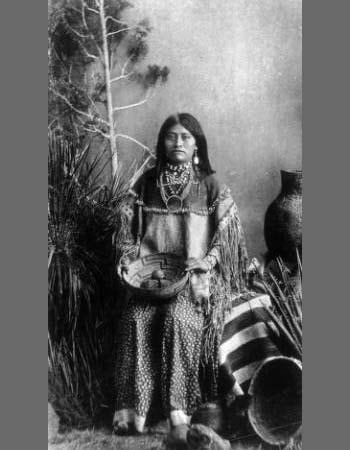
Dosey, a White Mountain Apache woman
Studio portrait of Dosey, a White Mountain Apache woman. She holds a woven basket and wears a beaded and fringed shawl and bead necklaces. Apaches were known for their intricate basket weaving.
Western History/Genealogy Department,
Denver Public Library
Call number X-32877
photo id: 1175
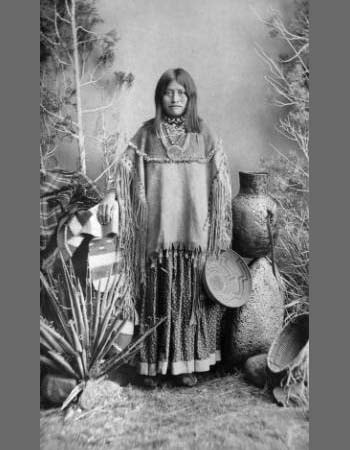
Daisy, White Mountain Apache
Standing studio portrait of Daisy, a White Mountain Apache woman wearing a fringed buckskin shirt or top with a calico full skirt and posed with baskets and blankets. Cloth dresses or skirts were common by 1850. This portrait was taken about 1883-1885.
Courtesy of Western History/Genealogy Dept.
Denver Public Library
X-32938
photo id: 1176
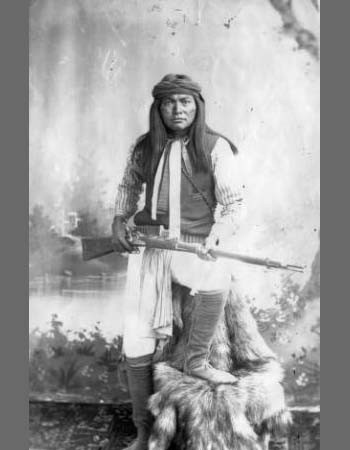
Apache Esh-kin-tsay-giza (Mike) White Mountain Indians Al-chi-say’s band
Studio portrait of Mike (Eshkintsaygiza), a White Mountain Apache Alchisay’s band man. He holds a rifle and wears boot moccasins, a breechcloth, ammunition belt, head bandolier, scarves around his neck, face paint, and a cloth headband. Photo taken between 1890 and 1920.
Courtesy of Western History/Genealogy Dept.,
Denver Public Library
Call number X-32879
photo id: 1177
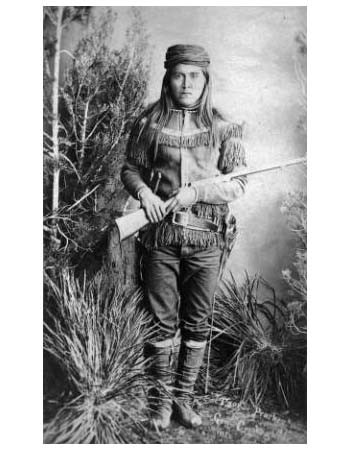
Title: Tzoch or Peaches, General Crooks White Mountain Apache Scout
Standing studio portrait of Peaches (Penaltish or Tzoch), a White Mountain Apache scout, wearing a fringe shirt, trousers, moccasins, a wrapped headband, ammunition belt with holstered handgun and rifle in hand.
Title hand-lettered on original, partially illegible; hand-written: “This is the renegade guide in Genl Crooks Campaign into the Sierra Madres, 83, (Peaches or Tzoch, White Mountain Apache) very light skin, full blooded, Lt Chaffee dubbed Peaches because such rosy cheeks, (?) by Crook loyal & trusty,” and photographer’s stamp on back of mat board.
Western History/Genealogy department,
Denver Public Library
Call Number x-32930
photo id: 1178
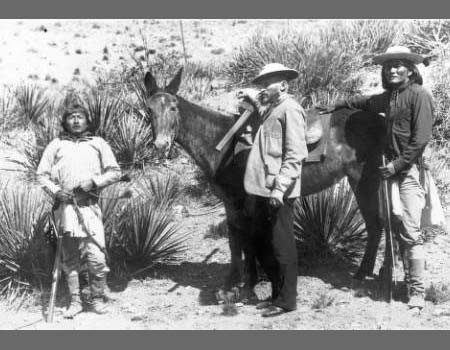
General Crook Campaign Photo
Captain General Crook stands with (Chiricahua) Dutchy (Ba-keetz-ogie, the Yellow Coyote on left and Al-chi-say, chief of the White Mountain Apaches, on right with rifles and Crook’s double barrel rifle.
Courtesy of
Western History/Genealogy Department,
Denver Public Library
Reproduction Number X-32954
photo id: 1179
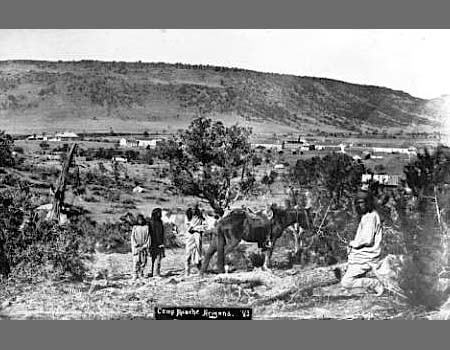
Camp Apache Arizona
Apache men and a white man pose near Fort Apache, Arizona. A saddled horse stands nearby. 1883
Western History/Genealogy Department,
Denver Public Library
Call Number X33462
photo id: 1180
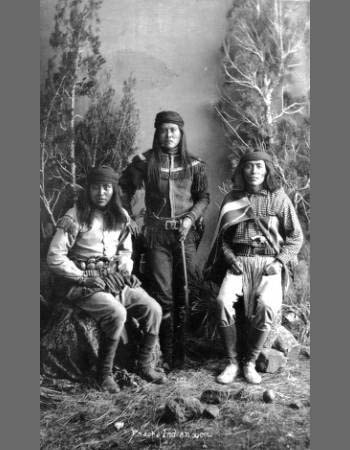
Indian Scouts 1880-1890
Studio portrait of White Mountain Apache scout, Peaches (Penaltish or Tzoch) and San Carlos scouts who served the U.S. military in the 1883 Apache Campaign to capture the Chiricahua band. (Date 1885?)
Courtesy of Western History/Genealogy Dept.,
Denver Public Library
photo id: 1181
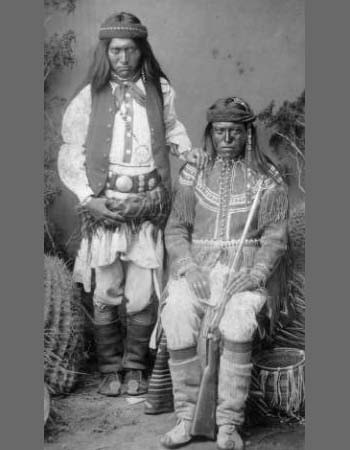
Nalte & brother, Gud-i-z-ah, White Mountain Apache Scouts for General Crook’s army
Studio portrait of two of the White Mountain Apaches who served as scouts for General Crook’s army, Nalte and brother Gud-i-z-ah. One holds a rifle and wears a concho buckskin war shirt and a war amulet strap in his hair, the other has a medicine cord for war protection diagonally across his chest. Both wear leggings, moccasins and headbands. Note the turned up toes of the moccasins; The turned up toe prevents injuring the foot. 1883
Courtesy of Western History/ Genealogy Department,
Denver Public Library Call number X-32924.
photo id: 1182
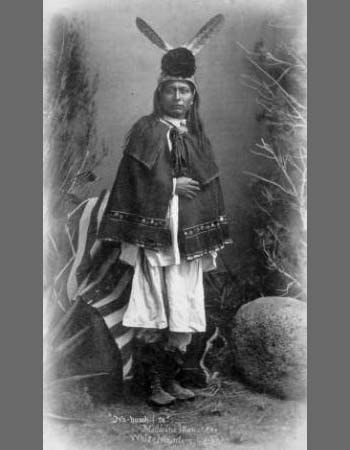
White Mountain Apache Medicine Man
Standing studio portrait of Nabuash-i-ta, White Mountain Apache medicine man wearing a cape and feathered medicine hat to protect him from bullets and arrows. The cap was made of turkey feathers tightly woven and with two eagle feathers attached. Normally used for social dances and occasionally for war parties.
Courtesy of Western History/Genealogy Dept.,
Denver Public Library
Call Number X32944
photo id: 1184
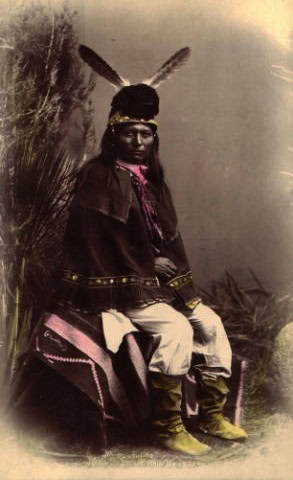
Na-buash-i-ta, Apache medicine man of White Mountain Apache
Seated studio portrait of Na-buash-i-ta, White Mountain Apache medicine man wearing a cap and animal fur medicine hat with two feathers, 1884?
Courtesy of Western History/Genealogy Department, Denver Public Library
Reproduction number X-32921
photo id: 1186
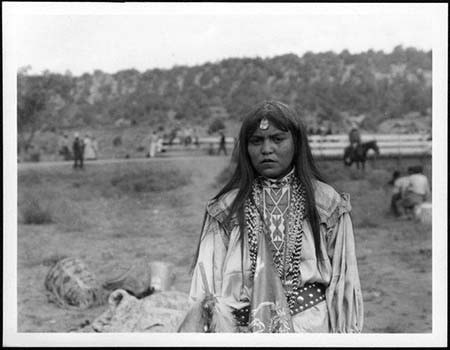
Apache girl dressed for ceremony
Young Apache girl dressed for Changing Woman Ceremony. The abalone shell tied to her forehead symbolizes the personification of the Changing Woman and will pick up the suns rays at sunrise. She is wearing the puberty necklace and carries a cane with an eagle plumes, bells and ribbons.
Repository Northern Arizona University Cline Library
Call Number NAU.PH.99.3.5.5.63
Item number 52143
Photo from http://archive.library.nau.edu
photo id: 1154
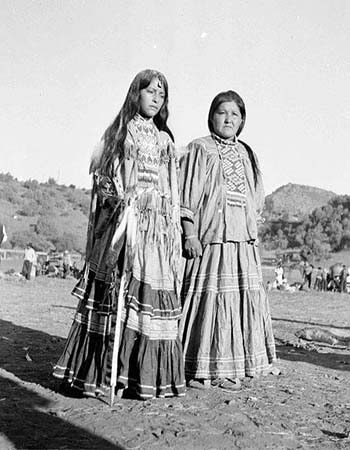
Changing Woman ceremony, girl with godmother
One young Apache woman wearing ceremonial dress and holding the ritual wooden cane which symbolizes long life. She carries a scratching stick and a water tube so as not to come into contact with her body. She wears a t-necklace. She stands with her Godmother, her chosen attendant throughout the ceremony.
Repository Northern Arizona University Cline Library
Colorado Plateau Collection
Call Number NAU.PH.99.3.5.5.21
Item number 51159
photo id: 1155

Ceremonial eagle feathers worn by girls at Changing Woman ceremony
The eagle feathers worn by the girls were to guide them at Na’I’es and hang over them even after they were removed. Note the feathers on the shoulders of the girls which were meant to carry the girls lightly and easily through the strenuous dancing of the four day ceremony.
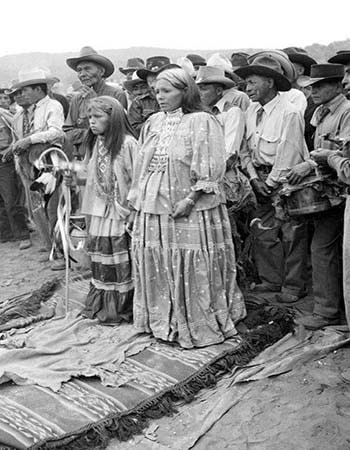
Solemn young Apache woman during Changing Woman Ceremony
Young Apache woman standing with Godmother. The girl must keep a solemn look on her face at all times during the four day ceremony as befits the occasion and her position.
Repository Northern Arizona University Cline Library
Call Number NAU.PH.99.3.5.5.75
Item Number 51193
Photo from http://archive.library.nau.edu
photo id: 1158
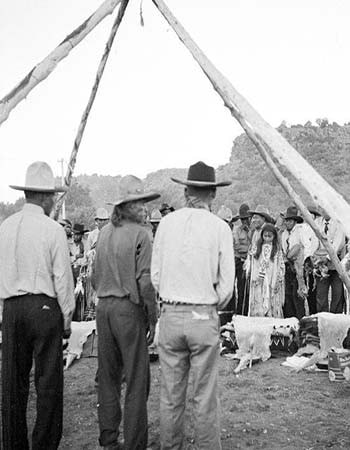
Ceremonial Tipi pole dwelling
As the girls slept a four pole tipi was constructed for them on the dance ground according to ceremony. The wood had to be carefully chosen and if broken had to be replaced as well as any other ritual articles.
Repository Northern Arizona University Cline Library
Call Number NAU.PH.99.3.5.5.14
Item number 51153
Photo from http://archive.library.nau.edu
photo id: 1159
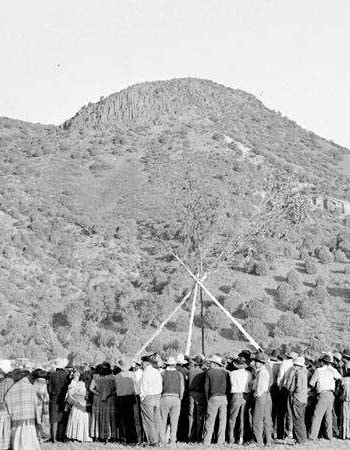
Everyone gathers around the ceremonial tipi in the Changing Woman Ceremony
During the ceremony, everyone gathers around the tipi to support the Changing Woman celebrant. As this is a four day ceremony, she is often left exhausted.
Repository Northern Arizona University Cline Library
Call Number NAU.PH.99.3.5.5.18
Item Number 51157
Photo from http://archive.library.nau.edu
photo id: 1160
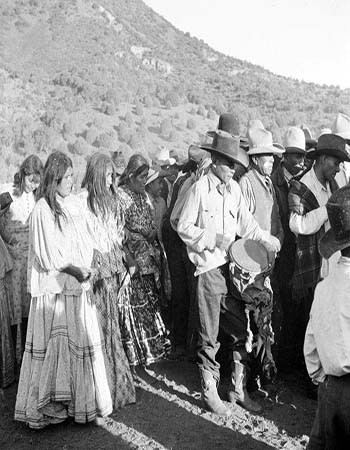
Apache girls with singers and helpers
Participants are led into a dance lasting four hours. They are now accompanied by a partner, usually a woman who has already done the Changing Woman ceremony and who will walk with them through the dance as a support. The women are led by the singers using drums.
Repository Northern Arizona University Cline Library
Call Number NAU.PH.99.3.5.5.38
Item Number 51178
Photo from http://archive.library.nau.edu
photo id: 1162
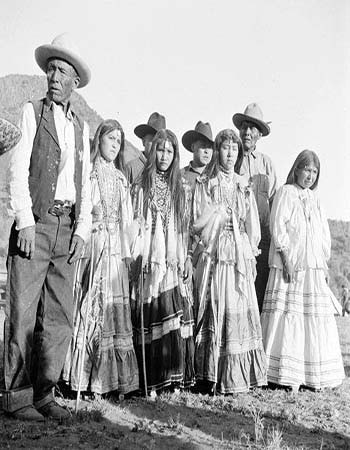
Apache women with singers during Changing Woman Ceremony
Young Apache women accompanied by singers. The changing woman ceremony is four days long, based on the time it took the beginning Changing Woman change from childhood to puberty. The singers pace the songs carefully, watching the girls for signs of exhaustion
Repository Northern Arizona University Cline Library
Call Number NAU.PH.99.3.5.5.23
Item Number 51163
Photo from http://archive.library.nau.edu
photo id: 1163
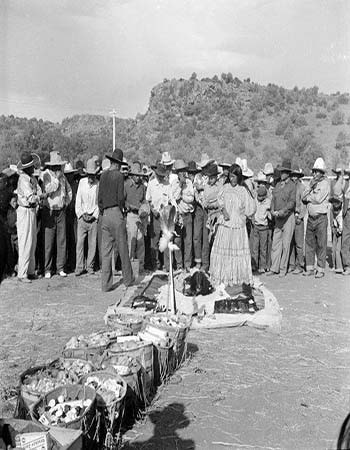
Changing Woman ceremonial objects
Changing Woman Ceremony. Eight blankets covered with deerskin are pointed towards the east. Baskets containing fruit and candy are lined up towards the East as well. A carved stick representing long life is stuck into the earth at the end of the blankets and various ceremonial items are left on the blanket. The girl is lying face down on the blanket. This may be the start of the ceremony or during the massage when the girl’s godmother massages the child prior to the next segment.
Repository Northern Arizona University cline Library
Call Number NAU.PH.99.3.5.5.26
Item 51166
Photo from http://archive.library.nau.edu
photo id: 1164

Changing Women participants accompanied by singers
Young Apache women accompanied by singers. The changing woman ceremony is four days long, based on the time it took the beginning Changing Woman change from childhood to puberty. The singers pace the songs carefully, watching the girls for signs of exhaustion.
Repository Northern Arizona University Cline Library
Call Number NAU.PH.99.3.5.5.23
Item Number 51163
Photo from http://archive.library.nau.edu
photo id: 1165
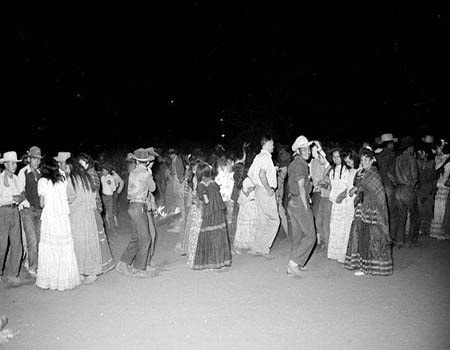
Social dance after ceremonies
Changing Woman ceremonies can often have 100-200 people in attendance. After Changing women ceremonies a big dance is often held.
Repository Northern Arizona University Cline Library
Call Number NAU.PH.99.3.5.5.82
Item Number 51153
Photo from http://archive.library.nau.edu
photo id: 1167
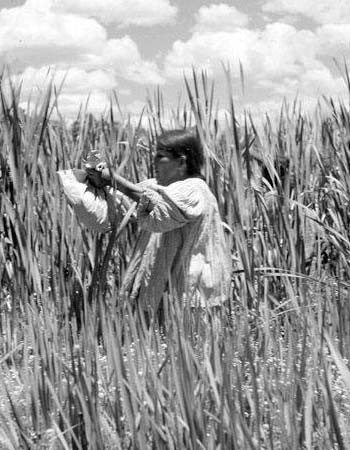
Pollen Gathering
Apache woman collecting pollen near McNary 1941.
Repository Northern Arizona University Cline Library
Call Number NAU.PH.99.3.5.9.1
Item number 51452
photo id: 1168

